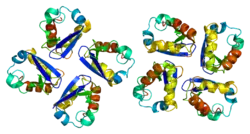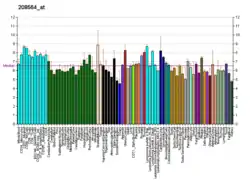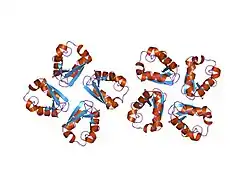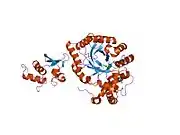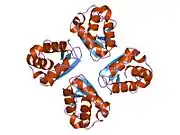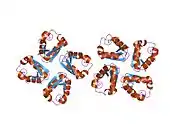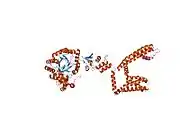KCNA2
Potassium voltage-gated channel subfamily A member 2 also known as Kv1.2 is a protein that in humans is encoded by the KCNA2 gene.[5][6]
Function
Potassium channels represent the most complex class of voltage-gated ion channels from both functional and structural standpoints. Their diverse functions include regulating neurotransmitter release, heart rate, insulin secretion, neuronal excitability, epithelial electrolyte transport, smooth muscle contraction, and cell volume. Four sequence-related potassium channel genes - shaker, shaw, shab, and shal - have been identified in Drosophila, and each has been shown to have human homolog(s). This gene encodes a member of the potassium channel, voltage-gated, shaker-related subfamily. This member contains six membrane-spanning domains with a shaker-type repeat in the fourth segment. It belongs to the delayed rectifier class, members of which allow nerve cells to efficiently repolarize following an action potential. The coding region of this gene is intronless, and the gene is clustered with genes KCNA3 and KCNA10 on chromosome 1.[6]
Interactions
KCNA2 has been shown to interact with KCNA4,[7] DLG4,[8] PTPRA,[9] KCNAB2,[7][10] RHOA[11] and Cortactin.[12]
Clinical
Mutations in this gene have been associated with hereditary spastic paraplegia.[13]
References
- GRCh38: Ensembl release 89: ENSG00000177301 - Ensembl, May 2017
- GRCm38: Ensembl release 89: ENSMUSG00000040724 - Ensembl, May 2017
- "Human PubMed Reference:". National Center for Biotechnology Information, U.S. National Library of Medicine.
- "Mouse PubMed Reference:". National Center for Biotechnology Information, U.S. National Library of Medicine.
- Gutman GA, Chandy KG, Grissmer S, Lazdunski M, McKinnon D, Pardo LA, Robertson GA, Rudy B, Sanguinetti MC, Stühmer W, Wang X (December 2005). "International Union of Pharmacology. LIII. Nomenclature and molecular relationships of voltage-gated potassium channels". Pharmacological Reviews. 57 (4): 473–508. doi:10.1124/pr.57.4.10. PMID 16382104.
- "Entrez Gene: KCNA2 potassium voltage-gated channel, shaker-related subfamily, member 2".
- Coleman SK, Newcombe J, Pryke J, Dolly JO (August 1999). "Subunit composition of Kv1 channels in human CNS". Journal of Neurochemistry. 73 (2): 849–58. doi:10.1046/j.1471-4159.1999.0730849.x. PMID 10428084.
- Eldstrom J, Doerksen KW, Steele DF, Fedida D (November 2002). "N-terminal PDZ-binding domain in Kv1 potassium channels". FEBS Letters. 531 (3): 529–37. doi:10.1016/S0014-5793(02)03572-X. PMID 12435606.
- Tsai W, Morielli AD, Cachero TG, Peralta EG (January 1999). "Receptor protein tyrosine phosphatase alpha participates in the m1 muscarinic acetylcholine receptor-dependent regulation of Kv1.2 channel activity". The EMBO Journal. 18 (1): 109–18. doi:10.1093/emboj/18.1.109. PMC 1171107. PMID 9878055.
- Nakahira K, Shi G, Rhodes KJ, Trimmer JS (March 1996). "Selective interaction of voltage-gated K+ channel beta-subunits with alpha-subunits". The Journal of Biological Chemistry. 271 (12): 7084–9. doi:10.1074/jbc.271.12.7084. PMID 8636142.
- Cachero TG, Morielli AD, Peralta EG (June 1998). "The small GTP-binding protein RhoA regulates a delayed rectifier potassium channel". Cell. 93 (6): 1077–85. doi:10.1016/S0092-8674(00)81212-X. PMID 9635436.
- Hattan D, Nesti E, Cachero TG, Morielli AD (October 2002). "Tyrosine phosphorylation of Kv1.2 modulates its interaction with the actin-binding protein cortactin". The Journal of Biological Chemistry. 277 (41): 38596–606. doi:10.1074/jbc.M205005200. PMID 12151401.
- Helbig KL, Hedrich UB, Shinde DN, Krey I, Teichmann AC, Hentschel J, Schubert J, Chamberlin AC, Huether R, Lu HM, Alcaraz WA, Tang S, Jungbluth C, Dugan SL, Vainionpää L, Karle KN, Synofzik M, Schöls L, Schüle R, Lehesjoki AE, Helbig I, Lerche H, Lemke JR (October 2016). "A recurrent mutation in KCNA2 as a novel cause of hereditary spastic paraplegia and ataxia". Annals of Neurology. 80 (4). doi:10.1002/ana.24762. PMC 5129488. PMID 27543892.
Further reading
- Paulmichl M, Nasmith P, Hellmiss R, Reed K, Boyle WA, Nerbonne JM, Peralta EG, Clapham DE (September 1991). "Cloning and expression of a rat cardiac delayed rectifier potassium channel". Proceedings of the National Academy of Sciences of the United States of America. 88 (17): 7892–5. doi:10.1073/pnas.88.17.7892. PMC 52410. PMID 1715584.
- Grissmer S, Dethlefs B, Wasmuth JJ, Goldin AL, Gutman GA, Cahalan MD, Chandy KG (December 1990). "Expression and chromosomal localization of a lymphocyte K+ channel gene". Proceedings of the National Academy of Sciences of the United States of America. 87 (23): 9411–5. doi:10.1073/pnas.87.23.9411. PMC 55175. PMID 2251283.
- McKinnon D (May 1989). "Isolation of a cDNA clone coding for a putative second potassium channel indicates the existence of a gene family". The Journal of Biological Chemistry. 264 (14): 8230–6. PMID 2722779.
- Kim E, Niethammer M, Rothschild A, Jan YN, Sheng M (November 1995). "Clustering of Shaker-type K+ channels by interaction with a family of membrane-associated guanylate kinases". Nature. 378 (6552): 85–8. doi:10.1038/378085a0. PMID 7477295.
- Klocke R, Roberds SL, Tamkun MM, Gronemeier M, Augustin A, Albrecht B, Pongs O, Jockusch H (December 1993). "Chromosomal mapping in the mouse of eight K(+)-channel genes representing the four Shaker-like subfamilies Shaker, Shab, Shaw, and Shal". Genomics. 18 (3): 568–74. doi:10.1016/S0888-7543(05)80358-1. PMID 7905852.
- Ramaswami M, Tanouy M, Mathew MK (August 1994). "Facile formation of heteromultimeric potassium channels by expression of cloned human cDNAs". Indian Journal of Biochemistry & Biophysics. 31 (4): 254–60. PMID 8002006.
- Nakahira K, Shi G, Rhodes KJ, Trimmer JS (March 1996). "Selective interaction of voltage-gated K+ channel beta-subunits with alpha-subunits". The Journal of Biological Chemistry. 271 (12): 7084–9. doi:10.1074/jbc.271.12.7084. PMID 8636142.
- Adda S, Fleischmann BK, Freedman BD, Yu M, Hay DW, Kotlikoff MI (May 1996). "Expression and function of voltage-dependent potassium channel genes in human airway smooth muscle". The Journal of Biological Chemistry. 271 (22): 13239–43. doi:10.1074/jbc.271.22.13239. PMID 8662756.
- Bonaldo MF, Lennon G, Soares MB (September 1996). "Normalization and subtraction: two approaches to facilitate gene discovery". Genome Research. 6 (9): 791–806. doi:10.1101/gr.6.9.791. PMID 8889548.
- Kim E, Sheng M (1997). "Differential K+ channel clustering activity of PSD-95 and SAP97, two related membrane-associated putative guanylate kinases". Neuropharmacology. 35 (7): 993–1000. doi:10.1016/0028-3908(96)00093-7. PMID 8938729.
- Cachero TG, Morielli AD, Peralta EG (June 1998). "The small GTP-binding protein RhoA regulates a delayed rectifier potassium channel". Cell. 93 (6): 1077–85. doi:10.1016/S0092-8674(00)81212-X. PMID 9635436.
- Tsai W, Morielli AD, Cachero TG, Peralta EG (January 1999). "Receptor protein tyrosine phosphatase alpha participates in the m1 muscarinic acetylcholine receptor-dependent regulation of Kv1.2 channel activity". The EMBO Journal. 18 (1): 109–18. doi:10.1093/emboj/18.1.109. PMC 1171107. PMID 9878055.
- Coleman SK, Newcombe J, Pryke J, Dolly JO (August 1999). "Subunit composition of Kv1 channels in human CNS". Journal of Neurochemistry. 73 (2): 849–58. doi:10.1046/j.1471-4159.1999.0730849.x. PMID 10428084.
- D'Adamo MC, Imbrici P, Sponcichetti F, Pessia M (August 1999). "Mutations in the KCNA1 gene associated with episodic ataxia type-1 syndrome impair heteromeric voltage-gated K(+) channel function". FASEB Journal. 13 (11): 1335–45. doi:10.1096/fasebj.13.11.1335. PMID 10428758.
- Wade GR, Laurier LG, Preiksaitis HG, Sims SM (October 1999). "Delayed rectifier and Ca(2+)-dependent K(+) currents in human esophagus: roles in regulating muscle contraction". The American Journal of Physiology. 277 (4 Pt 1): G885–95. doi:10.1152/ajpgi.1999.277.4.g885. PMID 10516156.
- Poliak S, Gollan L, Martinez R, Custer A, Einheber S, Salzer JL, Trimmer JS, Shrager P, Peles E (December 1999). "Caspr2, a new member of the neurexin superfamily, is localized at the juxtaparanodes of myelinated axons and associates with K+ channels". Neuron. 24 (4): 1037–47. doi:10.1016/S0896-6273(00)81049-1. PMID 10624965.
- Manganas LN, Trimmer JS (September 2000). "Subunit composition determines Kv1 potassium channel surface expression". The Journal of Biological Chemistry. 275 (38): 29685–93. doi:10.1074/jbc.M005010200. PMID 10896669.
- Kuryshev YA, Wible BA, Gudz TI, Ramirez AN, Brown AM (July 2001). "KChAP/Kvbeta1.2 interactions and their effects on cardiac Kv channel expression". American Journal of Physiology. Cell Physiology. 281 (1): C290–9. doi:10.1152/ajpcell.2001.281.1.c290. PMID 11401852.
- Byron KL, Lucchesi PA (March 2002). "Signal transduction of physiological concentrations of vasopressin in A7r5 vascular smooth muscle cells. A role for PYK2 and tyrosine phosphorylation of K+ channels in the stimulation of Ca2+ spiking". The Journal of Biological Chemistry. 277 (9): 7298–307. doi:10.1074/jbc.M104726200. PMID 11739373.
External links
- Kv1.2+Potassium+Channel at the US National Library of Medicine Medical Subject Headings (MeSH)
- KCNA2+protein,+human at the US National Library of Medicine Medical Subject Headings (MeSH)
This article incorporates text from the United States National Library of Medicine, which is in the public domain.
